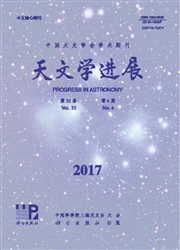

 中文摘要:
中文摘要:
极红天体(EROs)是指利用光学和近红外两个波段的色指数(如I-K〉4mag)挑选出来的一类星系。研究表明极红天体可分为两类:一类是被大量尘埃红化的高红移恒星形成星系,主要是较年轻的旋涡或不规则星系,有恒星正在形成,称为DGs;另一类是由年老星族(≥1Ga)主导的高红移椭圆星系,基本上没有或仅有弱的恒星形成,简称为OGs。极红天体中这两种不同类型的星系,很可能是近邻大质量星系的前身星系,只是分别代表着不同的形成历史。介绍了不同类型极红天体的各种物理性质的研究进展,如形态和结构、光谱特征、成团性、红移分布和星系计数等,以及阐述了该领域未来的研究方向。
 英文摘要:
英文摘要:
Extremely Red Objects (EROs) are massive galaxies (M* 〉 10^10.5 M⊙) char- acterized by extremely red opticaPto-infrared colors (e.g., (i -K)AB 〉 2.45 mag or (I - K)Vega 〉 4 mag) and high redshifts (z ≈ 1). EROS'are recognized to be primarily comprised of two interesting galaxy populations: Old passively evolving Galaxies (OGs) character- ized by old stellar populations, and Dusty star-forming Galaxies (DGs) reddened by a large amount of dust. EROs continue to be hot, on the one hand, the research in the literature suggests that they may be the direct progenitors of present-day massive E/S0 galaxies. On the other hand, they can provide crucial constraints on the current galaxy formation and evolution models. Observations show that OGs and DGs have different physical properties and formation processes. OGs in appearance are very similar to local early-type galaxies, compared to DGs. For the morphological properties of DGs, the majority of them show disk or irregular structures, which is similar to late-type galaxies we see today. The results from literatures suggest that DGs become increasingly important at fainter magnitudes, redder colors, and higher redshifts. Compared to DGs, major spectral features of OGs include 4000A break, [Ca II]H,K absorption features and no emission lines in the observable wavelength range. Moreover, observations demonstrate that the clustering of EROs is much stronger than that of full K-limited samples of galaxies, the clustering amplitude of OGs is by a factor of - 2 larger than that of DGs. For a given stellar mass, the mean size of OGs (DGs) is smaller by a factor of ≈ 2 (1.5) than that of present-day early-type (late-type) galaxies at rest-frame optical wavelength (λrest ≈ 6300A), implying that OGs and DGs have different evolutionary processes, and the minor merger scenario is the most likely mechanism for the structural properties of OGs. However, the size evolution of DGs is possibly due to the secular e
 同期刊论文项目
同期刊论文项目
 同项目期刊论文
同项目期刊论文
 期刊信息
期刊信息
